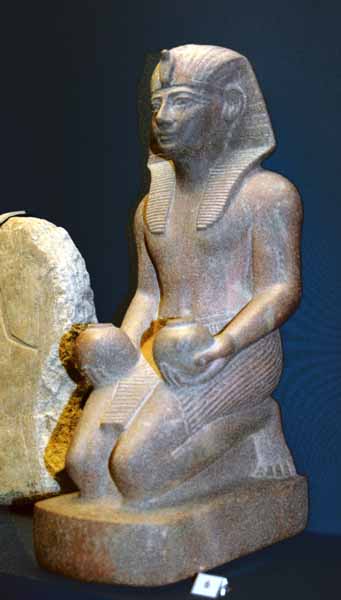
Statuette
of
Amenhotep
II
(Aakheperura,
ruled
1427
to
1400
BC),
Red
Quartzite
from
Kumma
Temple,
New
Kingdom,
18th
Dynasty
Figure
of
the
king,
represented
kneeling
on
a
pedestal
offering
two
pots
(probably
to
be
understood
as
containing
wine),
held
symmetrically
one
in
each
hand.
The
piece.
which
was
finely
carved
and
finished,
is
remarkably
well
preserved
with
hardly
a
blemish
on
its
carefully
polished
surface.
The
king
is
shown
wearing
the
shendyt-kilt
with
a
broad,
banded
belt
and
the
nerves-headdress
with
Uraeus.
its
tail
winding
hack
in
several
loops
to
the
crown
of
the
king's
head.
The
pedestal
is
roughly
rectangular
with
a
slightly
rounded
front.
At
the
rear
a
narrow
rectangular
pillar
extends
to
a
point
about
halfway
up
the
king's
back,
where
it
meets
the
queue
of
the
Nemes.
The
king's
face
is
broadly
triangular
in
shape,
with
high
cheekbones
and
a
small
delicate
chin,
turned
up
at
the
tip.
The
nose
is
large
and
long
(in
profile,
very
slightly
aquiline),
the
mouth
small
and
straight,
the
lips
quite
thick.
The
eyes,
rather
blandly
rendered
are
set
a
little
asymmetrically.
They
are
relatively
long
and
wide
with
rounded
eyeballs,
the
upper
lids
reproduced
as
a
raised
hand,
as
are
the
eyebrows
(which
curve
slightly)
and
the
cosmetic
lines
that
extend
from
the
outer
canthi.
The
ears
also
asymmetrical,
are
splayed
against
the
wings
of
the
nerves,
the
right
car
more
than
the
left.
The
overall
expression
is
serene
if
a
little
serious.
Although
it
lacks
an
inscription,
the
figure
can
he
identified
on
stylistic
grounds
as
a
representation
of
King
Amenhotep
II
(which
is
consistent
with
its
provenance).
Consolidating
their
rule,
the
Egyptian
pharaohs
of
the
mid-18th
Dynasty
embarked
on
a
substantial
programme
of
building
throughout
Nubia.
which
included
the
renovation
of
existing
structures.
The
largely
mud-brick
temple
of
Kumma,
a
foundation
of
Queen
Hatshepsut
and
Thutmose
III.
dedicated
to
the
ram-headed
Khnum
chief
god
of
the
cataract
region,
was
rebuilt
and
enlarged
by
Thutmose
III's
successor
Amenhotep
II,
using
sandstone
blocks.
The
Khartoum
figure
appears
to
have
been
one
of
a
group
of
such
statues
of
the
king
set
up
in
the
temple.